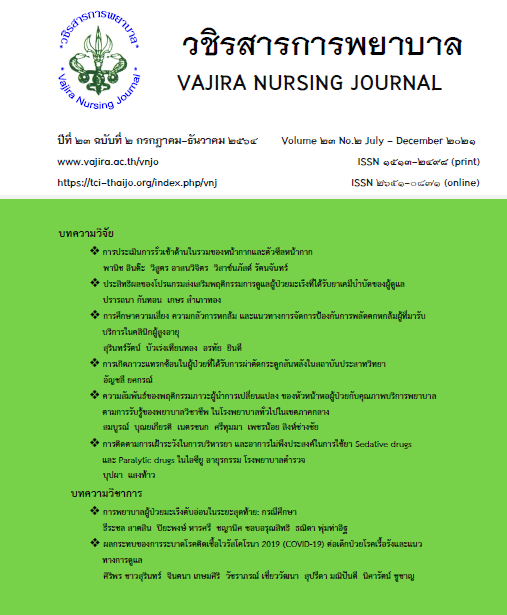การประเมินการรั่วเข้าด้านในรวมของหน้ากากและตัวซีลหน้ากาก
Main Article Content
บทคัดย่อ
วัตถุประสงค์ของงานนี้คือเพื่อประเมินการรั่วเข้าด้านในรวมของหน้ากากและตัวซีลหน้ากากในการศึกษานี้ได้ทำการทดสอบกับหน้ากากจำนวน 8 แบบคือ 1) หน้ากากอนามัย 2) หน้ากากอนามัยซ้อนทับ 2 ชั้น 3) หน้ากากผ้า 4) หน้ากากผ้าซ้อนทับ 2 ชั้น 5) หน้ากากผ้าซ้อนด้วยหน้ากากอนามัย 6) หน้ากาก N95แบบไม่มีวาล์ว 7) หน้ากาก N95 แบบมีวาล์ว และ 8) หน้ากาก N95 แบบไม่มีวาล์วซ้อนด้วยหน้ากากอนามัย และตัวซีลหน้ากากจำนวน 2 แบบคือ 1) แบบโครงซีลครอบด้านนอกของหน้ากากและ 2) แบบโครงซีลครอบด้านในของหน้ากาก โดยใช้วิธีการทดสอบตามมาตรฐานการป้องกันระบบทางเดินหายใจ 29 CFR 1910.134 ของ OSHA เพื่อหาค่าการรั่วเข้าด้านในรวมของตัวอย่างหน้ากากและตัวซีลหน้ากากกับกลุ่มตัวอย่างจำนวน 5 คนที่มีรูปใบหน้าแตกต่างกัน จากผลการทดสอบพบว่าการรั่วเข้าด้านในรวมผ่านหน้ากากอนามัยประมาณ 59.71% หน้ากากอนามัยซ้อนทับ 2 ชั้นประมาณ 31.76% หน้ากากผ้าประมาณ 62.80% หน้ากากผ้าซ้อนทับ 2 ชั้น ประมาณ 53.60% หน้ากากผ้าซ้อนด้วยหน้ากากอนามัยประมาณ 23.67% หน้ากาก N95 แบบไม่มีวาล์วประมาณ 0.91% หน้ากาก N95 แบบมีวาล์วประมาณ 9.50% และหน้ากาก N95 แบบไม่มีวาล์วซ้อนด้วยหน้ากากอนามัยประมาณ 0.88% สำหรับตัวซีลหน้ากากพบว่าหน้ากากอนามัยที่ใช้โครงซีลครอบด้านนอกมีการรั่วเข้าด้านในรวมประมาณ 7.54%และหน้ากากอนามัยที่ใช้โครงซีลครอบด้านในมีการรั่วเข้าด้านในรวมประมาณ 56.87% ข้อมูลจากการทดลองนี้จะเป็นประโยชน์อย่างมากต่อผู้บริโภคและผู้ที่สนใจในการเลือกใช้หน้ากากแต่ละแบบให้เหมาะกับระดับการป้องกัน
Article Details
เนื้อหาและข้อมูลในบทความที่ลงตีพิมพ์ในวชิรสารการพยาบาลถือเป็นข้อคิดเห็นและความรับผิดชอบของผู้เขียนบทความโดยตรง ซึ่งกองบรรณาธิการไม่จำเป็นต้องเห็นด้วย หรือร่วมรับผิดชอบใด ๆ ทั้งสิ้น
บทความ ข้อมูล เนื้อหา รูปภาพ ฯลฯ ที่ได้รับการตีพิมพ์ในวชิรสารการพยาบาล ถือเป็นลิขสิทธิ์ของวชิรสารการพยาบาล หากบุคคลใดหรือหน่วยงานใดต้องการนำทั้งหมดหรือส่วนหนึ่งส่วนใดไปเผยแพร่ต่อหรือเพื่อกระทำการใด ๆ จะต้องได้รับอนุญาตเป็นลายลักอักษรจากวชิรสารการพยาบาลก่อนเท่านั้น
เอกสารอ้างอิง
ASTM International. (2019). Standard Specification for Performance of Materials Used in Medical Face Masks (ASTM F2100-19e1). West Conshohocken, PA. Retrieved form https://www.astm.org/DATABASE.CART/HISTORI CAL/ F2100-19E1.htm.
Aydin, O., Emon, B., Cheng, S., Hong, L., Chamorro, L. P. & Saif, M. T. A. (2020). Performance of Fabrics for Home-made Masks Against the Spread of COVID-19 through Droplets: A Quantitative Mechanistic Study. Extreme Mechanics Letters, (40), 100924.
Anamai Media. (2021). How to Wear a Mask and Adhere to the D-M-H-T-T-A Principle is Enough to Prevent Disease. Retrieved form https://multimedia.anamai.moph.go.th/ news/210464/.
Christopher, B., Briana, C., Anil, A ., Simon S., Elaine, T., Xin, H.S.C., Lawrence, R. & Trisha, G. (2020). Performance and impact of disposable and reusable respirators for healthcare workers during pandemic respiratory disease: a rapid evidence review. Occupational and Environmental Medicine, 78(9), 679-690.
Department of Disease Control. (2021). COVID - 19 situation report. Retrieved form https://covid19.ddc. moph. go.th/.
Dugdale, C.M. & Walensky, R.P. (2020). Filtration Efficiency, Effectiveness, and Availability of N95 Face Masks for COVID-19 Prevention. JAMA Internal Medicine, 180(12), 1612-1613.
Intra, P. (2021A). Filtration efficiency of surgical masks, fabric masks and respirators available for use during the COVID-19 pandemic in Thailand. Thai Science and Technology Journal, in Press.
Intra, P. (2021B). Evaluation of the filtration efficiency of common fabric materials against 0.3 µm size particle. Thai Science and Technology Journal, in Press.
Intra, P. (2021C). Experiment on the motion of aerosol particles leaking from the mask. Retrieved form https://www.facebook.com/ruee.rmutl/
Konda, A., Prakash, A., Moss, G. A., Schmoldt, M., Grant, G. D. & Guha, S. (2020). Aerosol Filtration Efficiency of Common Fabrics Used in Respiratory Cloth Masks. ACS Nano, 14(5), 6339-6347.
Occupational Safety and Health Standards. (2006).Respiratory Protection Standard 29CFR1910.134. Retrieved form https://www.osha.gov/laws-regs/regulations/standardnumber/1910/1910.134
Rengasamy, S., Eimer, B. & Shaffer, R.E. (2010). Simple Respiratory Protection Evaluation of the Filtration Performance of Cloth Masks and Common Fabric Materials Against 20-1000 nm Size Particles. The Annals of Occupational Hygiene, 54(7), 789-798.
Rengasamy, S., Walbert, G.F., Newcomb, W.E., Faulkner, K., Rengasamy, MM., Brannen, JJ. & Szalajda, JV. (2014). Total inward leakage measurement of particulates for N95 filtering facepiece respirators--a comparison study. Ann Occup Hyg, 58(2), 206-216.
Rengasamy, S., Zhuang, Z., Niezgoda, G., Walbert, G., Lawrence, R., Boutin, B., Hudnall, J., Monaghan, WP., Bergman, M., Miller, C., Harris, J., & Coffey, C. (2018). A comparison of total inward leakage measured using sodium chloride (NaCl) and corn oil aerosol methods for air-purifying respirators. J Occup Environ Hyg, 15(8), 616-627.
Sickbert-Bennett, E.E., Samet, J.M., Clapp, P.W., Chen, H., Berntsen, J., Zeman, K.L., Tong, H., Bennett, D.J. & Bennett, W.D. (2020). Filtration Efficiency of Hospital Face Mask Alternatives Available for Use During the COVID-19 Pandemic. JAMA Internal Medicine, 180(12), 1607-1612.
Testex. (2009). Protective Face Masks, GB 2626-2019 and EN 149: 2001 + A1: 2009, Standards Comparison. Retrieved form https://www.testextextile.com/protective-face-masks-gb-2626-2019-and-en-149-2001-a1-2009-standards-comparison/
Whiley, H., Keerthirathne, T.P., Nisar, M.A., White, M.A.F. & Ross, K.E. (2020). Viral Filtration Efficiency of Fabric Masks Compared with Surgical and N95 Masks. Pathogens, 9(9), 762-769.


